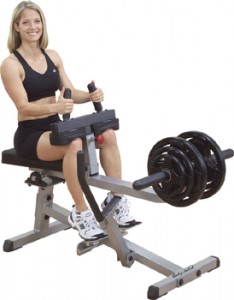
March 30, 2010
Changing Foot Position on Calf Raises
I routinely see people in the gym performing calf raises with their toes pointed every which way. They’ll turn their toes inward (pigeon-style), then forward, then outward…and pretty much every direction in between. All of this effort is undertaken in the mistaken belief that changing toe position allows you to work different areas of the calf muscle. Unfortunately this is not the case. Here’s why:
 In order to effectively alter the stimulation a muscle receives, you need to do one of two things: 1) increase the amount of stretch on the muscle or 2) place the fibers in a position so that they more directly oppose gravity or contract in line with fibers. Turning the feet in or out accomplishes neither of these objectives. These movements (called internal and external rotation) are achieved by rotating at the hip. The problem here is that the calves, of course, don’t cross the hip joint! They are affected only by movements that take place at the ankle and (in the case of the gastrocnemius) the knee joints. Hence, there’s no physiologic way foot position can be of benefit in enhancing calf development.
In order to effectively alter the stimulation a muscle receives, you need to do one of two things: 1) increase the amount of stretch on the muscle or 2) place the fibers in a position so that they more directly oppose gravity or contract in line with fibers. Turning the feet in or out accomplishes neither of these objectives. These movements (called internal and external rotation) are achieved by rotating at the hip. The problem here is that the calves, of course, don’t cross the hip joint! They are affected only by movements that take place at the ankle and (in the case of the gastrocnemius) the knee joints. Hence, there’s no physiologic way foot position can be of benefit in enhancing calf development.
What’s more, performing weighted calf movements with the feet splayed too far in or out can place undue stress on the knee joint. The knees simply aren’t meant to track in this fashion, and doing so can heighten the potential for soft-tissue injury.
So the question really becomes: Is there any way you can exert stimulation to different parts of calf muscles? The answer: To a limited degree. The gastrocnemius muscle has two separates “heads”: the medial head (which resides on the inside of the lower leg) and the lateral head (which resides on the outside of the lower leg). By rolling your foot onto the big toe (called inversion), you place the fibers of the medial head in a position to more directly oppose gravity, thereby increasing stress to this part of the muscle. Contrarily, by rolling your foot onto the little toe (called eversion), the fibers of the lateral head more directly oppose gravity, thus increasing their force production.
Now understand that this doesn’t mean you are isolating the respective heads. Far from it. Both heads will receive significant work during the exercise. If anything, the effect will be slight, with the target head being stimulated slightly more than the other.
Moreover, the soleus muscle (which lies deep underneath the gastroc), will not be affected by inversion or eversion. You can, however, target the soleus vis-à-vis the gastroc. Since the soleus only crosses the ankle joint and not the knee, it remains highly active when performing bent knee calf raises while the gastroc, which crosses both the ankle and knee, does not. Thus, exercises such as seated calf raises will focus more on the soleus whereas straight-legged movements (i.e. standing calf raises, donkey calf raises, etc), involve both the gastroc and the soleus.
Stay Fit!
Brad
3 Comments
RSS feed for comments on this post.
Sorry, the comment form is closed at this time.





 Entries (RSS)
Entries (RSS)




Randy, And your point about the Judge’s decision is…..? Éamonn, Dublin.
Comment by Gudrun Soltau — March 10, 2012 @ 1:37 am
Thank you. I just received a new program from my trainer and I am to change the position of my toes 3 different ways. After reading this I won’t be doing that and I’ll save my knees and some time 🙂
Comment by Tricia Martin — May 4, 2015 @ 9:29 am
I agree. I have often felt the same way with the rotation being at hip lets say, how could changing foot dynamics in any way work the calves differently. Glad someone else has confirmed my speculation…
Comment by Mike — February 27, 2016 @ 11:23 pm